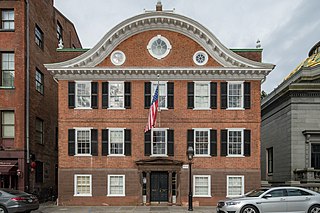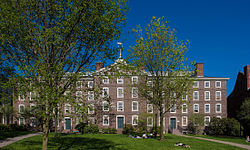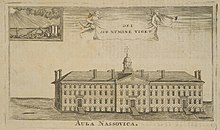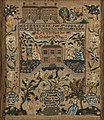
The First Baptist Meetinghouse also known as the First Baptist Church in America. It is the oldest Baptist church congregation in the United States. The Church was founded in 1638 by Roger Williams in Providence, Rhode Island. The present church building was erected between 1774 and 1775 and held its first meetings in May 1775. It is located at 75 North Main Street in Providence's College Hill neighborhood. It was designated a National Historic Landmark in 1960. It is affiliated with the American Baptist Churches USA.

Union Station describes two distinct, defunct train stations in Providence, Rhode Island. Parts of the latter one were renovated and the building contains offices and restaurants.

York and Sawyer was an American architectural firm active between 1898 and 1949. The firms' work is exemplary of Beaux-Arts architecture as it was practiced in the United States. The partners Edward York and Philip Sawyer (1868–1949) both trained in the office of McKim, Mead & White in the 1890s. In 1898, they established their independent firm, based in New York City.

College Hill is a historic neighborhood of Providence, Rhode Island, and one of six neighborhoods comprising the city's East Side. It is roughly bounded by South and North Main Street to the west, Power Street to the south, Governor Street and Arlington Avenue to the east and Olney Street to the north. The neighborhood's primary commercial area extends along Thayer Street, a strip frequented by students in the Providence area.

The John Hay Library is the second oldest library on the campus of Brown University in Providence, Rhode Island, United States. It is located on Prospect Street opposite the Van Wickle Gates. After its construction in 1910, the Hay Library became the main library building on campus, replacing the building now known as Robinson Hall. Today, the John Hay Library is one of five individual libraries that make up the University Library. The Hay houses the University Library's rare books and manuscripts, the University Archives, and the Library's special collections.

The Van Wickle Gates form the ornamental entrance to Brown University's main campus in Providence, Rhode Island. The gates stand at the intersection of College Street and Prospect Street at the crest of College Hill. Dedicated on June 18, 1901, they stand as a symbol for the campus and its 259-year history.

The John Brown House borders the campus of Brown University at 52 Power Street on College Hill in Providence, Rhode Island. Completed in 1788, it was the first mansion to be built in Providence and is named after its first owner, John Brown, a statesman, merchant, slave trader, and early benefactor of the University.

St. Joseph Church is parish of the Roman Catholic Church in Cumberland, Rhode Island within the Diocese of Providence. It is known for its historic campus at 1303 Mendon Road, which includes a Gothic Revival style church along with two late 19th-century, clapboard-sheathed, wood-frame structures on the east side of Mendon Road. The church and its accompanying buildings were added to the National Register of Historic Places in 1982 as St. Joseph's Church Complex.
The Blackstone Boulevard Realty Plat Historic District is a historic district roughly bounded by Blackstone Blvd., Rochambeau Ave., Holly St. and Elmgrove Ave. in Providence, Rhode Island.

The Market House is a historic three-story brick market house in Market Square, in the College Hill, a neighborhood of Providence, Rhode Island, USA. The building was constructed between 1773 and 1775 and designed by prominent local architects, Joseph Brown and Declaration of Independence signer Stephen Hopkins. The bottom floor of the house was used as a market, and the upper level was used for holding meetings. Similar buildings existed in other American cities, such as Faneuil Hall in Boston and the Old Brick Market in Newport. The building housed the Providence City Council in the decades before the completion of City Hall.

The Joseph and William Russell House is a historic house at 118 North Main Street in the College Hill area of Providence, Rhode Island, United States. It is a brick Georgian house built in 1772. Its original interior woodwork has been removed and distributed among museums around the United States.

The history of Brown University spans 260 years. Founded in 1764 as the College in the English Colony of Rhode Island and Providence Plantations, Brown is the seventh-oldest institution of higher education in the United States and the third-oldest institution of higher education in New England. At its foundation, the university was the first in the U.S. to accept students regardless of their religious affiliation. Brown's medical program is the third-oldest in New England while its engineering program is the oldest in the Ivy League.

Stephen Carpenter Earle was an architect who designed a number of buildings in Massachusetts and Connecticut that were built in the late 19th century, with many in Worcester, Massachusetts. He trained in the office of Calvert Vaux in New York City. He worked for a time in partnership with James E. Fuller, under the firm "Earle & Fuller". In 1891, he formed a partnership with Vermont architect Clellan W. Fisher under the name "Earle & Fisher".
Joseph Brown was an early American industrialist, architect, astronomer, and professor at Brown University.

Alpheus C. Morse (1818-1893) was an American architect with offices in Providence, Rhode Island.
Joseph M. Mosher (1888–1967) was an American architect practicing in Rhode Island during the mid-20th century. He designed many churches and schools around southern New England, after being associated with the office of Walter F. Fontaine for many years.

Second Empire architecture in the United States and Canada is an architectural style that was popular in both nations in the late 19th century between 1865 and 1900. Second Empire architecture was influenced by the redevelopment of Paris under Napoleon III's Second French Empire, and was influenced partly by the architectural styles of the French Renaissance.

The Lafayette College campus is a 110-acre suburban area located on College Hill in Easton, Pennsylvania, United States. Lafayette College also owns and maintains a 230-acre athletic complex, the Metzgar Fields Athletic Complex. The school is roughly 70 mi (110 km) west of New York City and 60 mi (97 km) north of Philadelphia.

The Joseph Brown House is a historic Georgian house located at 50 South Main Street Providence, Rhode Island. The building, designed by astronomer and amateur architect Joseph Brown, is the oldest extant house built by an American architect for his own use.
























